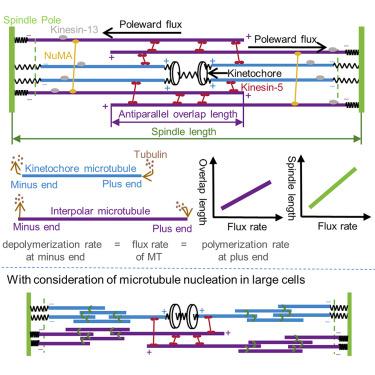Mechanism of spindle stability and poleward flux regulating spindle length during the metaphase
IF 4.1
2区 综合性期刊
Q1 MULTIDISCIPLINARY SCIENCES
引用次数: 0
Abstract
During metaphase, the spindle stabilizes chromosomes and maintains its size despite continuous microtubule poleward flux. To investigate the mechanism of the spindle stability and how the poleward flux regulates the spindle size, we establish a minimal spindle model that incorporates kinetochores, microtubules, spindle poles, and microtubule sliding proteins such as kinesin-5, microtubule depolymerizing proteins such as kinesin-13, and microtubule crosslinking proteins such as NuMA. We find that the poleward flux stabilizes the spindle by regulating the spindle length and the length of antiparallel microtubule overlaps to achieve equal rates of microtubule sliding, plus-end polymerization, and minus-end depolymerization. We reveal the underlying mechanism of how the poleward flux rate scales linearly with the spindle length and microtubule overlap length in small cells and how microtubule nucleation affects spindle dynamics in large cells.

中期主轴稳定性和极向通量调节主轴长度的机制
在中期,纺锤体稳定染色体并保持其大小,尽管微管不断向两极流动。为了研究纺锤体稳定性的机制以及极性通量如何调节纺锤体的大小,我们建立了一个最小纺锤体模型,该模型包含着丝点、微管、纺锤极和微管滑动蛋白(如kinesin-5)、微管解聚蛋白(如kinesin-13)和微管交联蛋白(如NuMA)。我们发现,极性通量通过调节主轴长度和反平行微管重叠的长度来稳定主轴,从而实现微管滑动、正端聚合和负端解聚的相同速率。我们揭示了在小细胞中,极化通量如何与纺锤体长度和微管重叠长度成线性关系,以及微管成核如何影响大细胞中的纺锤体动力学的潜在机制。
本文章由计算机程序翻译,如有差异,请以英文原文为准。
求助全文
约1分钟内获得全文
求助全文
来源期刊

iScience
Multidisciplinary-Multidisciplinary
CiteScore
7.20
自引率
1.70%
发文量
1972
审稿时长
6 weeks
期刊介绍:
Science has many big remaining questions. To address them, we will need to work collaboratively and across disciplines. The goal of iScience is to help fuel that type of interdisciplinary thinking. iScience is a new open-access journal from Cell Press that provides a platform for original research in the life, physical, and earth sciences. The primary criterion for publication in iScience is a significant contribution to a relevant field combined with robust results and underlying methodology. The advances appearing in iScience include both fundamental and applied investigations across this interdisciplinary range of topic areas. To support transparency in scientific investigation, we are happy to consider replication studies and papers that describe negative results.
We know you want your work to be published quickly and to be widely visible within your community and beyond. With the strong international reputation of Cell Press behind it, publication in iScience will help your work garner the attention and recognition it merits. Like all Cell Press journals, iScience prioritizes rapid publication. Our editorial team pays special attention to high-quality author service and to efficient, clear-cut decisions based on the information available within the manuscript. iScience taps into the expertise across Cell Press journals and selected partners to inform our editorial decisions and help publish your science in a timely and seamless way.
 求助内容:
求助内容: 应助结果提醒方式:
应助结果提醒方式:


